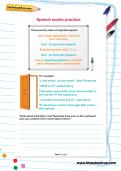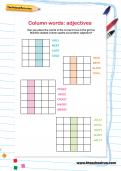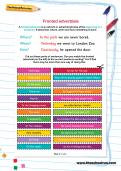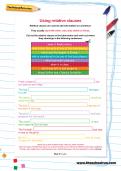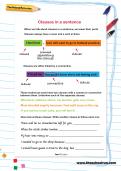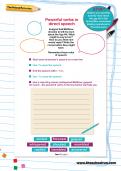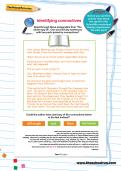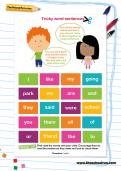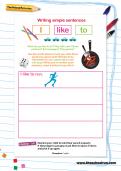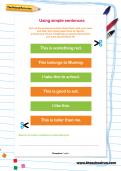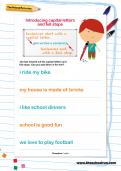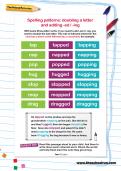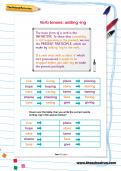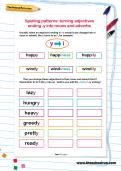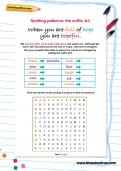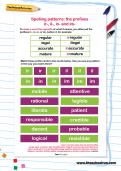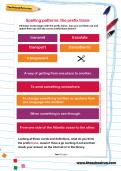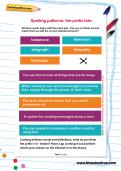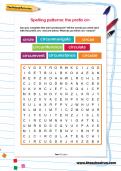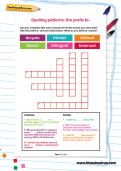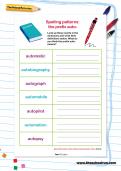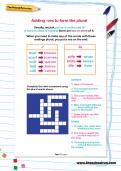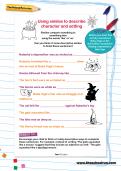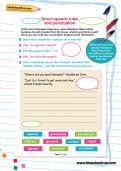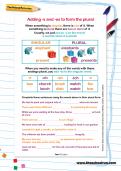Grammar worksheets
Free worksheets: Grammar, KS2
You’ll need to login or Register first to access these worksheets for free.
Once you’ve tried out our free worksheets, why not explore all our resources (1000s of worksheets, interactive tutorials, learning packs and more) with a 14-day FREE trial subscription.
Speech marks practice
Can you continue this conversation between Harry and Thenusha using the correct rules for reported speech? Remember to start each character’s speech on a new line. Use “ to open the speech. End the speech with !, ? or , and use ” to close the speech. Use a reporting clause (a verb like said, whispered or announced).
Column words: adjectives
Can you place the words in the correct rows in the grid so that the shaded column spells out another adjective?
Fronted adverbials: examples and meaning
A teacher-created, fronted adverbial worksheet that provides an explanation of what a fronted adverbial is, with examples and a football-themed activity. Cut out these parts of sentences. Can you match the fronted adverbial to the correct sentence ending?
Using relative clauses
Relative clauses are used to add information to a sentence. They usually start with when, who, that, which or whose. In this teacher-created worksheet for primary school children, you will need to cut out the relative clauses in the table and work out where they should go in the sentences.
Clauses in a sentence
When we talk about clauses in a sentence, we mean their parts. Clauses always have a noun and a verb in them and are often linked by a connective. These sentences each have two clauses with a comma or connective between them. Underline each of the separate clauses.
Powerful verbs in direct speech
Start by reading 'The stolen spy kit' then imagine that Matthew decides to tell his mum about the Spy Kit. What might he say to her? How do you think she would reply? Write the conversation they might
have. Remember the rules of speech!
have. Remember the rules of speech!
Identifying connectives
Read through these paragraphs from ‘The stolen spy kit’. Can you find any sentences with two parts joined by connectives? Could the author have used any of the connectives below in the text instead?
Tricky word sentences
Cut out the words and see if you can put some of them together to make sentences. You can stick them onto another sheet of paper if you like, and add a full stop at the end.
Writing simple sentences
What do you like to do? Play with cars? Draw pictures? Eat sausages? Play games? Use the words above to help you write three sentences about what YOU like to do. Remember to use capital letters and full stops! When you’ve written each sentence, draw a picture to go with it.
Using simple sentences
Cut out the sentences below. Read them with your mum and dad, then sticky-tape them to objects around your house. Challenge an adult to find where you have placed them all!
Introducing capital letters and full stops
Sentences start with a capital letter and end with a full stop. Jim has missed out his capital letters and full stops. Can you add them in for him?
Spelling patterns: doubling a letter and adding -ed / -ing
With some three-letter verbs, if you need to add -ed or -ing, you need to double the last letter. This rule is followed whenever the verb has a short vowel followed by a consonant. Read this passage aloud, then write down each coloured word. Check the words and then learn to spell any you get wrong.
Verb tenses: adding -ing
The basic form of a verb is the INFINITIVE. To show that something is still happening in the present, we use the PRESENT PARTICIPLE, which we make by adding -ing to the verb. If a verb ends with a silent ‘e’ which isn’t pronounced it needs to be dropped before you add -ing to make the present participle. Cover over the table. Can you write the correct words ending -ing in the spaces below?
Spelling patterns: turning adjectives ending -y into nouns and adverbs
Usually, when an adjective ending in –y needs to be changed into a noun or adverb, the y turns to an i. Can you change these adjectives to their noun and adverb form? Remember to turn the y into an i before you add the -ness / -ly ending!
Spelling patterns: the suffix -ful
We use the suffix -ful to make adjectives, but watch out – although the word ‘full’ has been put on the end of ‘hope’, the last l is dropped. Can you complete this table to show how words are changed by adding the suffix-ful? Then find all the words ending -ful above in this wordsearch.
Spelling patterns: the prefixes ir-, il-, in- and im-
To make a word the opposite of what it means, you often put the prefixes ir-, il-, in- or im- before it. Match these prefix cards to the words below. Can you see any pattern in the way you match them?
Spelling patterns: the prefix trans-
All these words begin with the prefix trans-. Can you cut them out and match them up with the correct definitions below? Looking at these words and definitions, what do you think the prefix trans- means? Have a go working it out and then check your answer on the internet or in the library
Spelling patterns: the prefix tele-
All these words begin with the prefix tele-. Can you cut them out and match them up with the correct definitions below?
Spelling patterns: the prefix cir-
Can you complete this mini-wordsearch? All the words you need start with the prefix circ- and are below. What do you think circ- means?
Spelling patterns: the prefix bi-
Can you complete this mini-crossword? All the words you need start with the prefix bi- and are listed below. What do you think bi- means?
Spelling patterns: the prefix auto-
Look up these words in the dictionary and write their definitions below. What do you think the prefix auto means?
Adding -ves to form the plural
Can you complete this fun mini-crossword with the plurals of these words? Be careful though – you can't just add -s to these words like you normally would to make a word plural.
Using similes to describe character and setting
Similes compare something to something else using the words ‘like’ or ‘as’. Can you think of some descriptive similes to finish these sentences?
Direct speech rules and punctuation
Read the Baba Yaga story, the write the conversation that you think Natasha’s father (Otto) might have with his wife (Ivanka) when he banishes her from the house. Remember the rules of direct speech and punctuation.
Adding -s and -es to form the plural
When something is singular, there is one of it. When something is plural there are two or more of it. Usually, we just put an -s on the end of a word to show it is plural. But to make some words plural we need to add -es to the singular word. Can you complete these sentences using the words above in their plural form?
